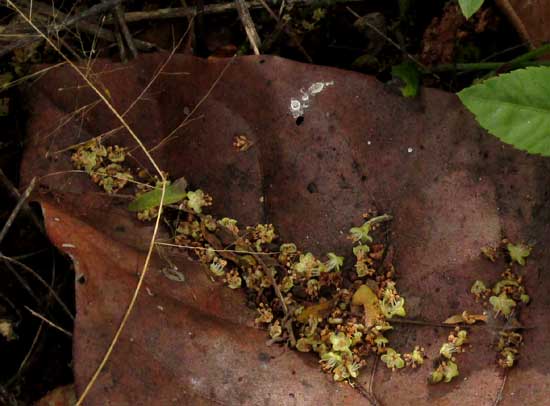Excerpts from Jim Conrad's
Naturalist Newsletter
from the September 24, 2017 Newsletter issued from Rancho Regensis north of Valladolid, Yucatán, MÉXICO
BOOB, THE "GRAPE TREE"
It's a special pleasure to meet a new tree. This week I found one I've been wanting to see for a long time, so it's a double pleasure. It grew so enmeshed with other trees and vines at a forest edge that it was impossible to see whether it was a tree or a woody vine, but I knew from the literature that it can grow to 100ft (30m). The tree is especially striking now because it's bearing its fruits. Below, you can see a branch with its large, broad, leathery leaves and long clusters of grape-like fruits:
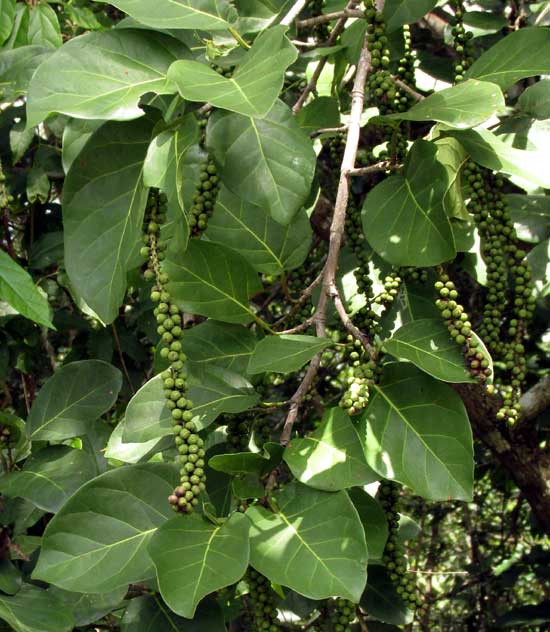
A closer look at a fruit cluster is hown below:
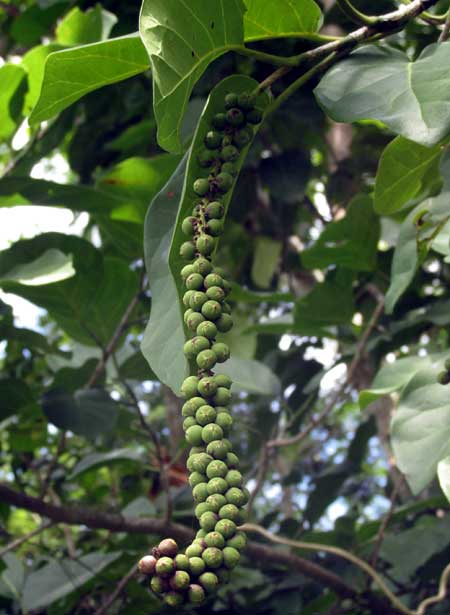
This is COCCOLOBA SPICATA, with no good English or Spanish name. The tree is so special it deserves some kind of handle, so I've learned its Maya name, which is Boob. Using the Maya name is appropriate because it occurs only in the Maya area -- the Yucatan Peninsula, Belize and part of Guatemala.
If you've seen Sea-Grapes along tropical America's sandy beaches, from southern Florida to South America, you've encountered a close relative of Boob. Sea-Grapes is Coccoloba uvifera, so Boob is a species in the same genus as Sea-Grapes. You might enjoy comparing our Boob pictures with those of Sea-Grapes on our page at www.backyardnature.net/yucatan/seagrape.htm
The genus Coccoloba resides in the Buckwheat or Knotweed Family, the Polygonaceae. A distinctive field mark of members of that family consists of the conspicuous stipules that commonly form a collar-like sheath, or "ocrea," around the stem at the point of petiole attachment. The ocrea encircling the stems of Boob are especially worth noticing, as seen below:

In that picture the ocreae are green at their bases and brown and tattered at their tops.
Despite this being my first time to see Boob fruiting, the plant is common here. A 15ft-tall (4.5m) Boob stands exactly in front of the hut's porch, beside the wasp nest, and a smaller one grows to the side. I've seen hundreds around knee to shoulder high. They're very conspicuous because of the leaves' large size and shiny, leathery surface. But all those encounters have been with non-flowering, non-fruiting plants. Why are flowering/fruiting Boob trees so rare? I asked my Maya friends about it.
They say it's because the Boob is so useful -- people cut down the larger ones, the trunks being used as thatch supports for the thatch roofs on their traditional huts. Far from the roads, they tell me, you can still see plenty of mature Boob trees flowering and fruiting.
Also they say that when they can't find banana leaves in which to wrap their tamales, they look for Boob leaves, which are so leathery that they make good wrappers. A study of the medicinal flora of Oxtankah, just north of Chetumal on the Yucatan's southern Caribbean coast, found Boob traditionally used for treating asthma
from the May 31, 2018 Newsletter issued from Rancho Regenesis in the woods ±4kms west of Ek Balam Ruins; elevation ~40m (~130 ft), N~20.876°, W~88.170°; central Yucatán, MÉXICO
"GRAPE TREE" FLOWERING
Now at the beginning of the new rainy season, our larger Grape Trees look like the one shown below:
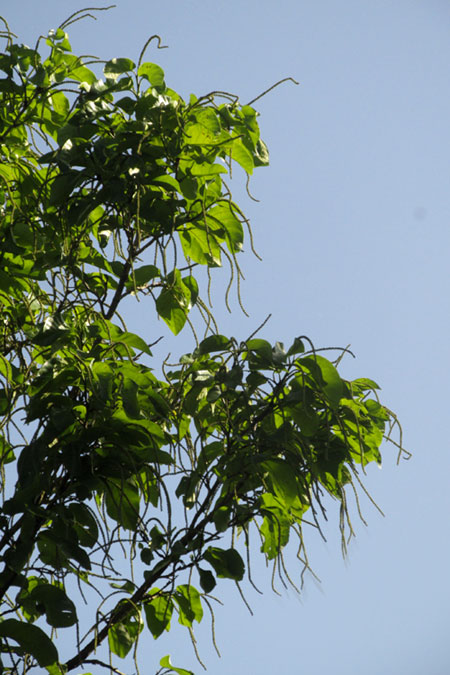
Those dangling items are clusters of tiny, greenish flowers, some of which you can see below:
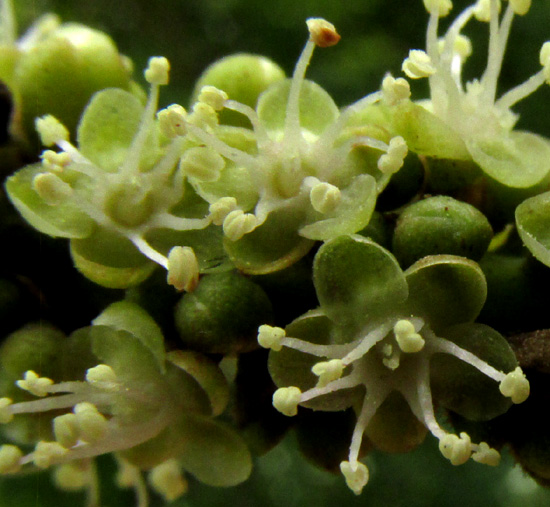
As with all members of the Buckwheat Family, these flowers produce no corollas. The items that look like corolla lobes or petals are calyx sepals doing corolla duty, normally referred to as "tepals." In these flowers the eight stamens unite at their filament bases into a kind of low rim around the spherical ovary. The ovaries are very small relative to the stamens, and I suspect that at the stage shown in the picture the stamens are sexually mature, but the ovary isn't, preventing self pollination.
from the June 7, 2018 Newsletter issued from Rancho Regenesis in the woods ±4kms west of Ek Balam Ruins; elevation ~40m (~130 ft), N~20.876°, W~88.170°; central Yucatán, MÉXICO
"GRAPES" BEGINNING TO FORM
One week after the above flower pictures were taken, most of the same tree's flowers have been pollinated and fallen off, and the ovaries already are on their way to becoming grape-like fruits, as shown below:

In that picture you can see that a few flowers still are open. Also, in the image's top, left corner, notice the tiny, strange looking critter I didn't notice until the picture was on the computer screen. If it's not a spider, it's a very curious-looking little being.
During this last week the tree's flower-fall has been prodigious. Below, you can see dropped corollas gathered in the fold of a fallen leaf:
